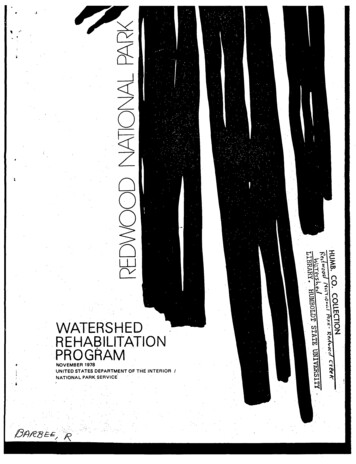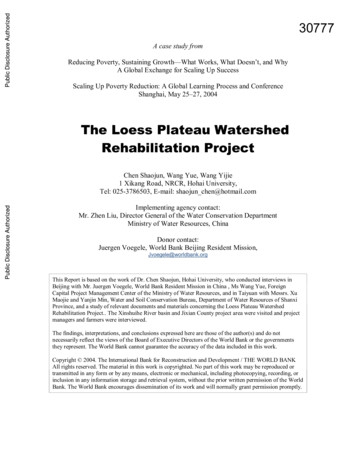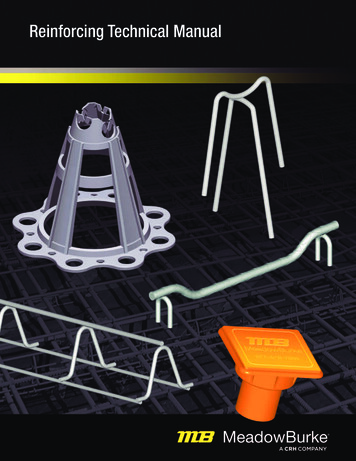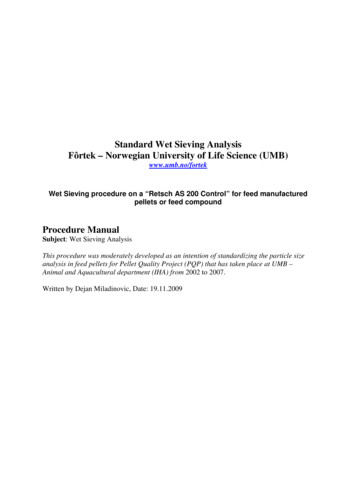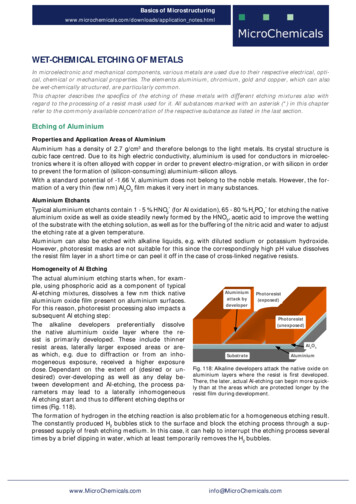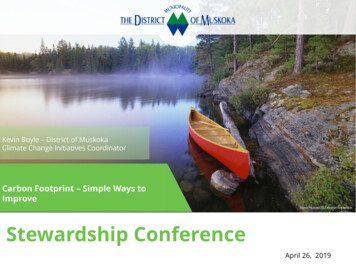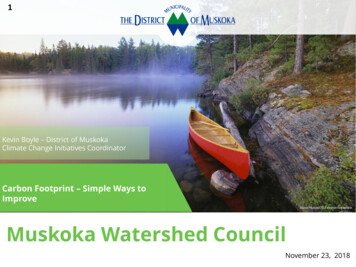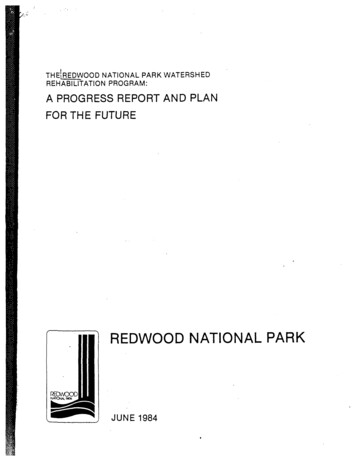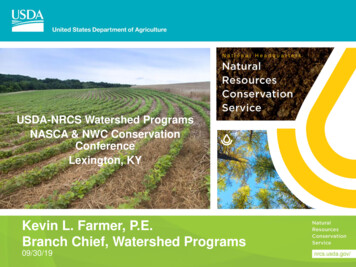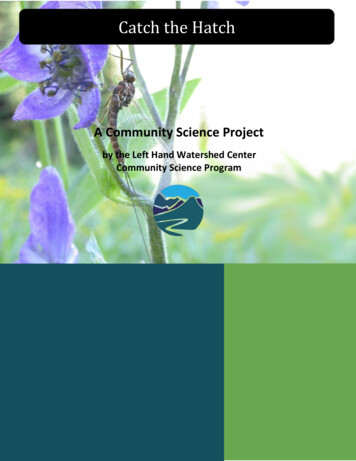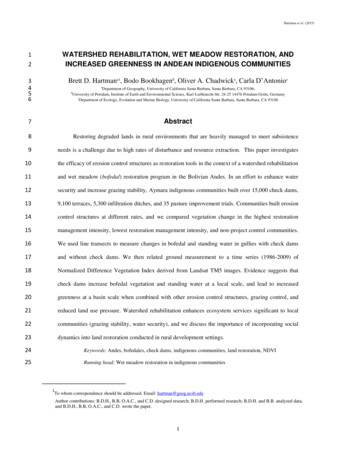
Transcription
Hartman et al. (2015)12WATERSHED REHABILITATION, WET MEADOW RESTORATION, ANDINCREASED GREENNESS IN ANDEAN INDIGENOUS COMMUNITIES3456Brett D. Hartmana1, Bodo Bookhagenß, Oliver A. Chadwicka, Carla D’Antonioγ7AbstractaDepartment of Geography, University of California Santa Barbara, Santa Barbara, CA 93106;University of Potsdam, Institute of Earth and Environmental Science, Karl-Liebknecht-Str. 24-25 14476 Potsdam-Golm, GermanyγDepartment of Ecology, Evolution and Marine Biology, University of California Santa Barbara, Santa Barbara, CA 93106ß8Restoring degraded lands in rural environments that are heavily managed to meet subsistence9needs is a challenge due to high rates of disturbance and resource extraction. This paper investigates10the efficacy of erosion control structures as restoration tools in the context of a watershed rehabilitation11and wet meadow (bofedal) restoration program in the Bolivian Andes. In an effort to enhance water12security and increase grazing stability, Aymara indigenous communities built over 15,000 check dams,139,100 terraces, 5,300 infiltration ditches, and 35 pasture improvement trials. Communities built erosion14control structures at different rates, and we compared vegetation change in the highest restoration15management intensity, lowest restoration management intensity, and non-project control communities.16We used line transects to measure changes in bofedal and standing water in gullies with check dams17and without check dams. We then related ground measurement to a time series (1986-2009) of18Normalized Difference Vegetation Index derived from Landsat TM5 images. Evidence suggests that19check dams increase bofedal vegetation and standing water at a local scale, and lead to increased20greenness at a basin scale when combined with other erosion control structures, grazing control, and21reduced land use pressure. Watershed rehabilitation enhances ecosystem services significant to local22communities (grazing stability, water security), and we discuss the importance of incorporating social23dynamics into land restoration conducted in rural development settings.24Keywords: Andes, bofedales, check dams, indigenous communities, land restoration, NDVI25Running head: Wet meadow restoration in indigenous communities1To whom correspondence should be addressed. Email: hartman@geog.ucsb.eduAuthor contributions: B.D.H., B.B, O.A.C., and C.D. designed research; B.D.H. performed research; B.D.H. and B.B. analyzed data;and B.D.H., B.B, O.A.C., and C.D. wrote the paper.1
Hartman et al. (2015)Highlights2627We analyze the effectiveness of watershed restoration conducted in rural development settings28where resources are managed to meet subsistence needs. Results suggest that significant land29restoration can be achieved through a combination of intensive restoration management (erosion30control structures) and passive restoration (grazing control, reduced land use pressure).31We present a large-scale and long-term analysis of the effect of check dams and other erosion32control structures, indicating that significant ecosystem services (grazing stability, water security)33are enhanced at high levels of restoration management intensity.Introduction3435Significant portions of the world's tropics have been degraded by human use, with land36degradation concentrated in dryland montane areas managed by the rural poor (Bridges and37Oldeman 1999; Lambin et al. 2003; Lepers et al. 2005; Bai et al. 2008). Local and indigenous38people can be effective at ecosystem restoration, provided there is sufficient social coordination39and mobilization (e.g. Walters 2000; Long et al. 2003; Mingyi et al. 2003; Badola & Hussain402005; Walton et al. 2006; Stringer et al. 2007; Blay et al. 2008). However, restoration efforts in41rural environments that are heavily managed to meet subsistence needs are often complicated by42high levels of disturbance from agriculture, grazing, fire, and biomass harvest (Brown & Lugo431994; Lamb et al. 2005). There is a need to better understand land restoration dynamics in rural44development settings where land use pressure is high, and management objectives include45restoring ecosystem services important to local communities such as grazing stability and water46security.4748One geographic region where intensive management by rural poor populations has led toenvironmental degradation is the Central Andes of South America (Ellenberg 1979; Baied &2
Hartman et al. (2015)49Wheeler 1993; Chepstow-Lusty et al. 1998). The Central Andes are dominated by dry, tropical50montane Puna grasslands composed of bunchgrasses, tropical alpine rosette-forming herbs, and51dwarf shrubs in upland positions, and bofedal vegetation in seeps, springs, wet meadows, and52floodplains (Squeo et al. 2006). Large portions of the Central Andes have been degraded due to53population growth, changes in land management, and infrastructural development (Siebert 1983).54Degradation is characterized by reduced vegetative cover and productivity (Brandt & Townsend552006), changes in species composition (Laegard 1992; Catorci et al. 2013), increased runoff and56erosion (Harden 1996, 2001; Valentin et. al. 2005), and deforestation of remnant Polylepis57woodlands (Kessler 2002; Sarmiento and Frolich 2002).58Bofedales are particularly sensitive to changes in hydrology induced by gully erosion or59prolonged drought (Earle et al. 2003; Moreau & Toan 2003; Squeo et al. 2006; Washington-60Allen et al. 2008). Bofedal degradation impacts local livelihoods, as they are a vital source of dry61season grazing for llamas and sheep. In the absence of active management, degraded bofedales62may be slow to recover, remain suppressed at lower levels of productivity, or continue to63degrade (Beisner et al. 2003; Scheffer & Carpenter 2003; Avni 2005). However, bofedales can64be restored through watershed rehabilitation that includes erosion control and grazing65management (Lal 1992; Alemayehu et al. 2009). For example, check dams in gullies reduce66water flow velocity and increase sediment deposition, soil moisture, bank stability, and riparian67vegetation (Bombino et al. 2008; Boix-Fayos 2008; Zeng et al. 2009). Grazing management68increases biomass and productivity, improves species composition, and promotes infiltration69(Diaz et al. 1994; Preston et al. 2002; Buttolph & Coppock 2004; Chu et al. 2006; Catorci et al.702013; Mekuria &Veldkamp 2012). Although the local effects of erosion control structures and3
Hartman et al. (2015)71grazing management are relatively well understood, their large-scale and long-term effectiveness72have not been evaluated.73This paper investigates the efficacy of erosion control structures as restoration tools in the74context of a watershed rehabilitation and bofedal restoration program in the Bolivian Andes.75Specifically, we evaluate the effect of check dams and other erosion control structures on bofedal76vegetation and Puna grasslands, and if there are any additive effects from increased restoration77management intensity. Evaluating long-term and large-scale responses to watershed management78requires a combination of ground measurement and remote sensing. We conducted ground79measurement of vegetation via line transects established in gullies with check dams and without80check dams. We then related ground measurement to a time-series (1986 – 2009) of Normalized81Difference Vegetation Index (NDVI) derived from Landsat TM5 images. NDVI is a robust tool82to measure relative changes in greenness that is correlated with biomass and productivity83(Anderson et al. 1993; Lu et al. 2004). NDVI has been used as an indicator of land degradation84in grassland and forest biomes (e.g. Thiam 2003; Wessels et al. 2004; Chen & Rao 2008;85Almeida-Filho & Carvalho 2010) and can be used as an indicator of ecosystem recovery86following restoration management (Kelly & Harwell 1990). NDVI derived from satellite imagery87is especially useful for post-Hoc analysis when pre-project baseline information is not available88(Malmstrom et al. 2008). The results indicate that check dams increase bofedal vegetation at a89local scale, but also lead to extensive areas of land restoration when combined with other erosion90control structures, grazing control, and reduced land use pressure.4
Hartman et al. (2015)919293Study AreaGeographic settingThe study area is a traditional Aymara territory – the Ayllu Majasaya-Aransay-Urunsaya94– in the Tapacarí Province, Department of Cochabamba, Bolivia. Situated along the95Cochabamba-Oruro Highway on the Eastern Cordillera of the Andes (Figure 1), elevation ranges96from approximately 3,800 – 4,650 m. Mean annual precipitation is about 400 mm/yr, with 90%97of the rain falling between November and March (Oruro Station – Instituto Nacional de98Estadisticas de Bolivia, http://www.ine.gob.bo/). Daily temperature fluctuations are high, with99high levels of solar insolation during the day (xˉ Daily Max 19.2ºC) alternating with cold nights100(xˉ Daily Min -0.17ºC). Frosts generally occur in May and June. Dust, high winds and hypoxia101are also components of this environment.102Bofedal degradation103Land degradation in the study area is set within a context of population growth, rural-104urban migration, and land use changes resulting from land reforms in 1952. Overgrazing and105cultivation on steep frost-prone slopes led to decreased vegetative cover, severe gully erosion,106altered hydrologic cycles, and reduced productivity. Bofedales in the study area were particularly107impacted by land degradation and gully erosion. Bofedales are vulnerable to changes in108hydrology (Squeo et al. 2006, Washington-Allen et al. 2008), and land degradation can impact109bofedales through the following mechanisms: 1) reduced vegetative cover, increased runoff, and110decreased infiltration rates reduce groundwater recharge rates, causing dry season water stress111for wetland plants; 2) gullies that incise through bofedales increase groundwater outflow rates,112also causing dry season water stress; 3) increased sediment transported from slopes can cover5
Hartman et al. (2015)113bofedales, causing plant mortality and increasing the soil elevation relative to the water table;114and 4) increased flow velocities in channels can increase vegetation scour, degrading bofedales115in channels and floodplains.116Moisture gradients and grazing intensity drive bofedal species composition (Bosman et117al. 1993, Ruthsatz 2012, Salvador et al. 2014). Cushion-forming species such as Distichlis118humilis (Poaceae), Plantago tubulosa (Plantaginaceae), and Ranunculus flagelliformis119(Ranunculaceae) are dominant in low-lying rivulets, pools and saturated areas. In mesic120hummocks and mounds, diminutive rosette species such as Hypochoeris taraxicoides121(Asteraceae), Hypsela reniformis (Campanulaceae), and Viola pygmaea (Violaceae) become122more common. If dry season water stress occurs due to erosion, grassland species such as123Festuca dolicophylla (Poaceae), Calamagrostis rigescens (Poaceae), Azorella biloba (Apiaceae)124and Lachemilla pinnata (Rosaceae) colonize the bofedales. Local people report that such125degraded bofedales support limited dry season grazing.126Watershed rehabilitation and wet meadow restoration127Land restoration efforts began in 1992 in a partnership between the Ayllu Majasaya-128Aransya-Urunsaya and a non-governmental organization, the Dorothy Baker Environmental129Studies Center (CEADB). The project eventually expanded to include over 30 communities and130multiple resource management organizations. Local communities typically built check dams in131community work groups (aines), starting at the headwaters and working downstream as gullies132stabilized. In later stages, communities built terraces and infiltration ditches on slopes through a133food-for-work program. Local communities built a total of 15,000-20,000 check dams, 9,1006
Hartman et al. (2015)134terraces, 5,300 infiltration ditches, 36 gabions, 35 pasture improvement trials (enclosures), and13512 stock ponds, and planted 1,670 trees (CEADB project records).136Methods137138Study basin selectionThis research formed part of a broader study linking social variables with biophysical139indicators of restoration success conducted from 2010 to 2014. The sample design was based on140a comparative analysis of 4 High-Restoration Management Intensity (HighRMI), 4 Low-141Restoration Management Intensity (LowRMI), and 4 NonProject control communities (Figure 2,142Table 1). Check dams, terraces, and infiltration ditches are the predominant watershed143management technology within the project area, and there is a high degree of variability in the144density of erosion control structures (ECSs) in project participant communities (from 14.7 –145225.3 ECSs/km2, CEADB project records). Within the context of the watershed rehabilitation146program at the Ayllu Majasaya-Aransaya-Urunsaya, Restoration Management Intensity was147defined as:148RMI No ErosionControlStructures/km2149HighRMI and LowRMI communities were identified from the project participant150communities after controlling for elevation range, geology and soils, vegetation types,151production methods, cultural norms and practices, and social structure. NonProject control152communities were selected along the same ridgeline as the project area, and they also exhibited153similar biophysical and social characteristics. However, control communities were not154immediately adjacent to the study area in order to reduce the potential for auto-correlation. As7
Hartman et al. (2015)155the NonProject control communities were in a different Ayllu, the level of interaction with156project area communities was minimal. There were two additional communities included in the157study (Thaya Laka and Chulpani) that had medium levels of RMI, and data from these158communities was included in the Pearson’s correlations as described below.159Study basins were delineated using a 30-m resolution ASTER Global DEM V2160downloaded from the NASA Land Process and Distributed Active Archive Center. The DEM161was re-projected to WGS-84 UTM Zone 19S with 30-m spatial resolution, consistent with the162Landsat TM5 images. Watersheds were defined using standard GIS techniques, and the basin163boundaries were delineated by merging polygons based on comparison with: 1) detailed sketch164maps created by local communities (CEADB project records), 2) GPS points of key landmarks,165and 3) ground-truthing with community informants in 2012. In general, the community166boundaries followed ridgelines, but if the community boundary was a river, the polygons were167clipped along the river centerline.168169Line transectsLine transects were established in 5 gullies with check dams and in 5 gullies without170check dams to investigate potential changes in vegetation cover associated with check dams, and171to relate this information to NDVI. Gullies were selected at random after they were stratified,172using the following rules. First, the headwaters were between 10 – 25 hillslope angles (above17325 slopes, water flow velocities is such that all vegetation is scoured from gullies, and below17410 slopes water velocity is low enough that bofedal vegetation cover is high, regardless of175whether or not there are check dams). Second, the gully was located on the northeast side of the176ridgeline rather than on southwest slopes (this reduced aspect related variability due to solar8
Hartman et al. (2015)177insolation and evapotranspiration rates). Once a gully was selected, the transect start point was178randomly selected from 100 – 300 m below the confluence of the two feeder primary channels,179in the upper reaches of the secondary channels. Line transects consisted of placing a 25-m tape180measure down the center line of the gully. A total of four 25-m line transects were laid end-to-181end in each sample gully (n 5x4x2). Due to the natural meander of the gullies, each 25-m182section of the tape measure crossed representative topographic positions, including the central183thalweg, the gully bottom, and portions of the side slopes that encroached on the line. The start184and end point of each cover type (bofedal vegetation, Puna grassland, standing water, and bare185areas) was measured to cm, and these values were converted to linear length and percent cover186for each 25-m section. The cover of different particle size classes in the bare areas was also noted187as follows: bedrock, cobbles, gravel, and sand. However, as the main interest was in changes in188vegetation cover, the bare areas were aggregated for the statistical analysis.189190Remote sensing methodsA time series of Landsat TM5 images from 1986 – 2009 was constructed to evaluate191long-term trends in NDVI. A total of twelve Landsat TM5 scenes were acquired for the study192area. The images were acquired during the same time period in each sample year, on satellite193overpasses between May 12 and June 3. This period was selected in order to capture the dry-194down immediately following the rainy season. Images were generally free of clouds and haze.195Images were acquired from USGS and from the Brazilian National Institute for Space Research196(INPE) receiving station. All images were projected in WGS-84 UTM Zone 19S and clipped to197the study area boundary (upper left 712425 E, 8073235 S; lower right 764895 E, 8017705 S),198and an image-to-image co-registration was performed using 28 – 100 automatically generated9
Hartman et al. (2015)199ground control points assisted by hand selected tie points. The resulting mean RMS error was20013.14 m. The 1989 image was part of the USGS Global Land Survey (GLS), therefore the201Landsat TM5 images were well aligned with the DEM. Following co-registration, all images202were radiometrically calibrated with a Dark Object Subtraction (Chavez 1988).203Normalized Difference Vegetation Index values were calculated for each 30-m resolution204pixel. Vegetation indices derived from remotely sensed data can be useful tools to measure205relative greenness and predicting green biomass (Carlson and Ripley 1997; Chen and Cihlar2061996). NDVI is a good metric across a wide variety of biomes, although it can saturate due to207high NIR reflectance from soils in some low biomass and high LAI systems. NDVI was208calculated using the red (RED) TM Band 3 (0.63 – 0.69 μm) and near-infrared (NIR) TM Band 4209(0.76 – 0.90 μm), where:210211A 3x3 low pass filter was applied to smooth the NDVI values in each image to account212for inter-annual variability and any remaining pixel offset from the co-registration process. A213mask was created to account for areas within the study area that may have unreliable NDVI214values. A Maximum Likelihood Supervised Classification, using Regions of Interest (ROIs)215defined by areas of known cover types, was used to identify rock outcrops, sparsely vegetated216areas (convex shale outcrops with sparse vegetation), roads, shadow, and glint areas (pixels with217abnormally high DN values). As NDVI values in these areas were considered unreliable and218unaffected by watershed management, they were aggregated to create the RockOutcrop mask.219Some bare portions of river channels and gullies were misclassified as rock outcrop. Therefore, a10
Hartman et al. (2015)220terrain analysis was performed, using the DEM as input, and a second WetMask was created.221The WetMask was defined as any areas that were both concave and 10 hillslope angles, and222then added back into to the image to create a final mask. The resulting mask focused the sample223area primarily on the channels and adjacent valley bottoms, as well as gently sloping, well-224vegetated Puna grassland slopes. Of the total of 262.57 km2 in the study basins, 96.29 km2 was225masked out, leaving a total of 167.28 km2 or 63.47% of the study basins.226Points were selected in gullies
74 context of a watershed rehabilitation and bofedal restoration program in the Bolivian Andes. 75 Specifically, we evaluate the effect of check dams and other erosion control structures on bofedal 76 vegetation and Puna grasslands, and if there are any additive effects from increased restoration 77 management intensity. Evaluating long-term .
